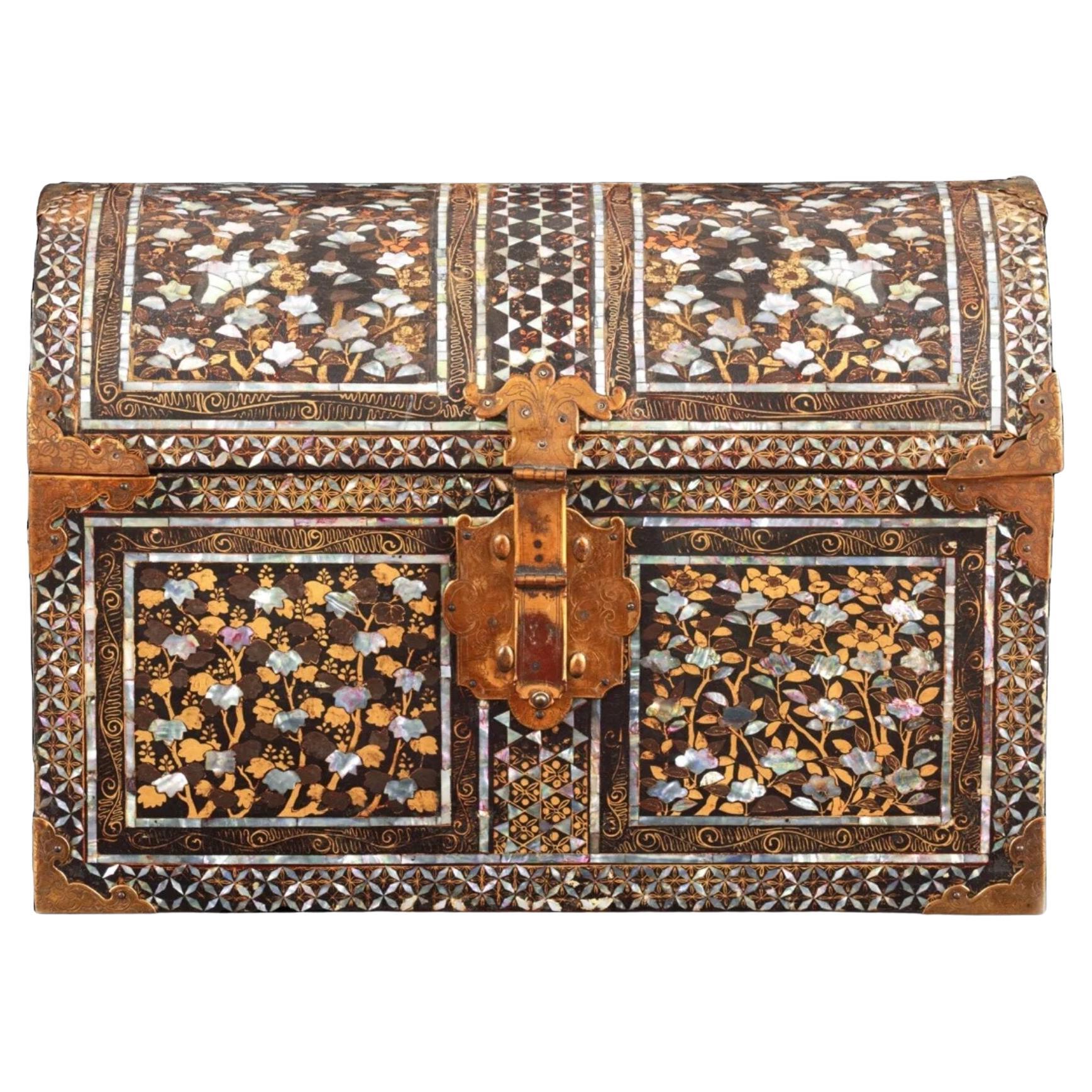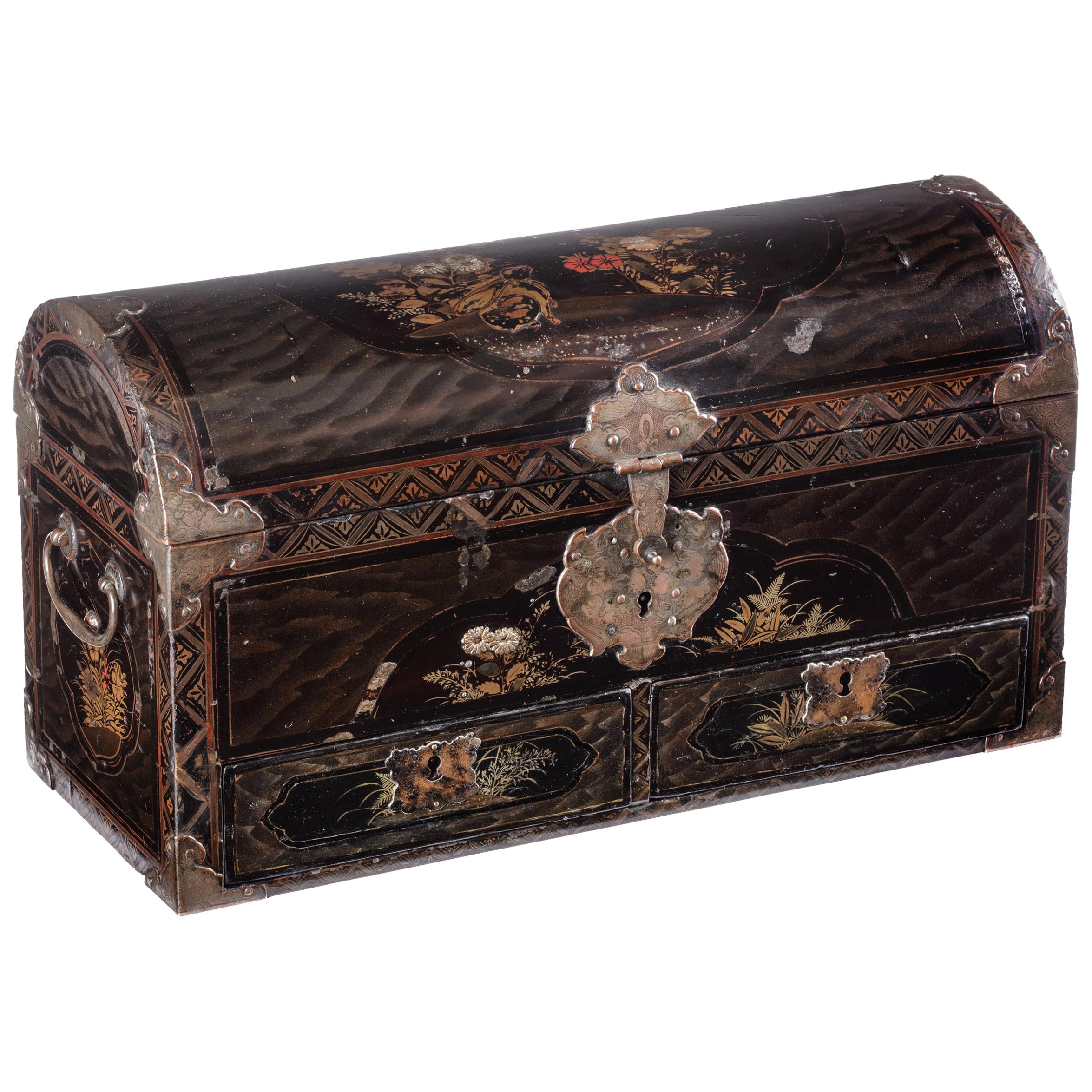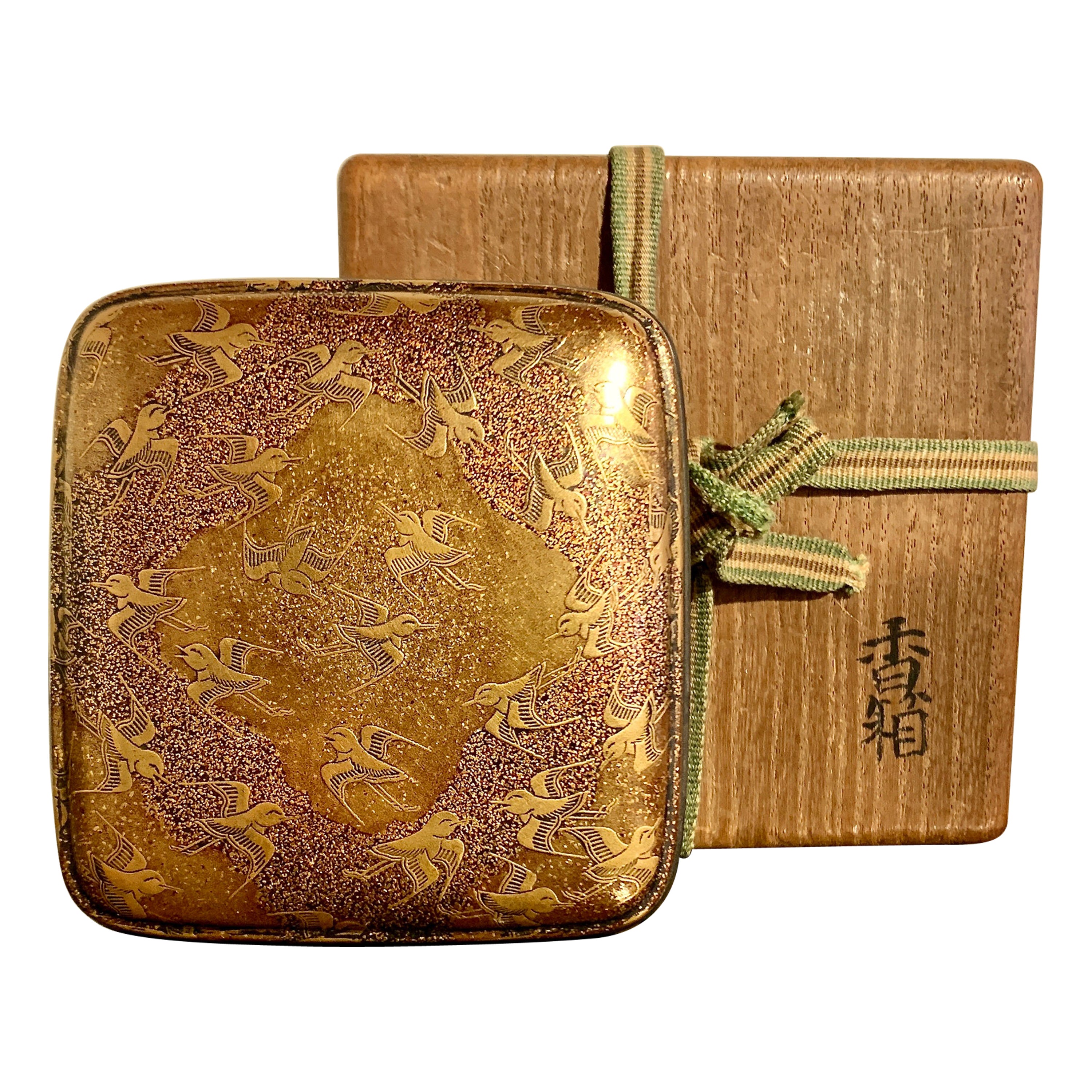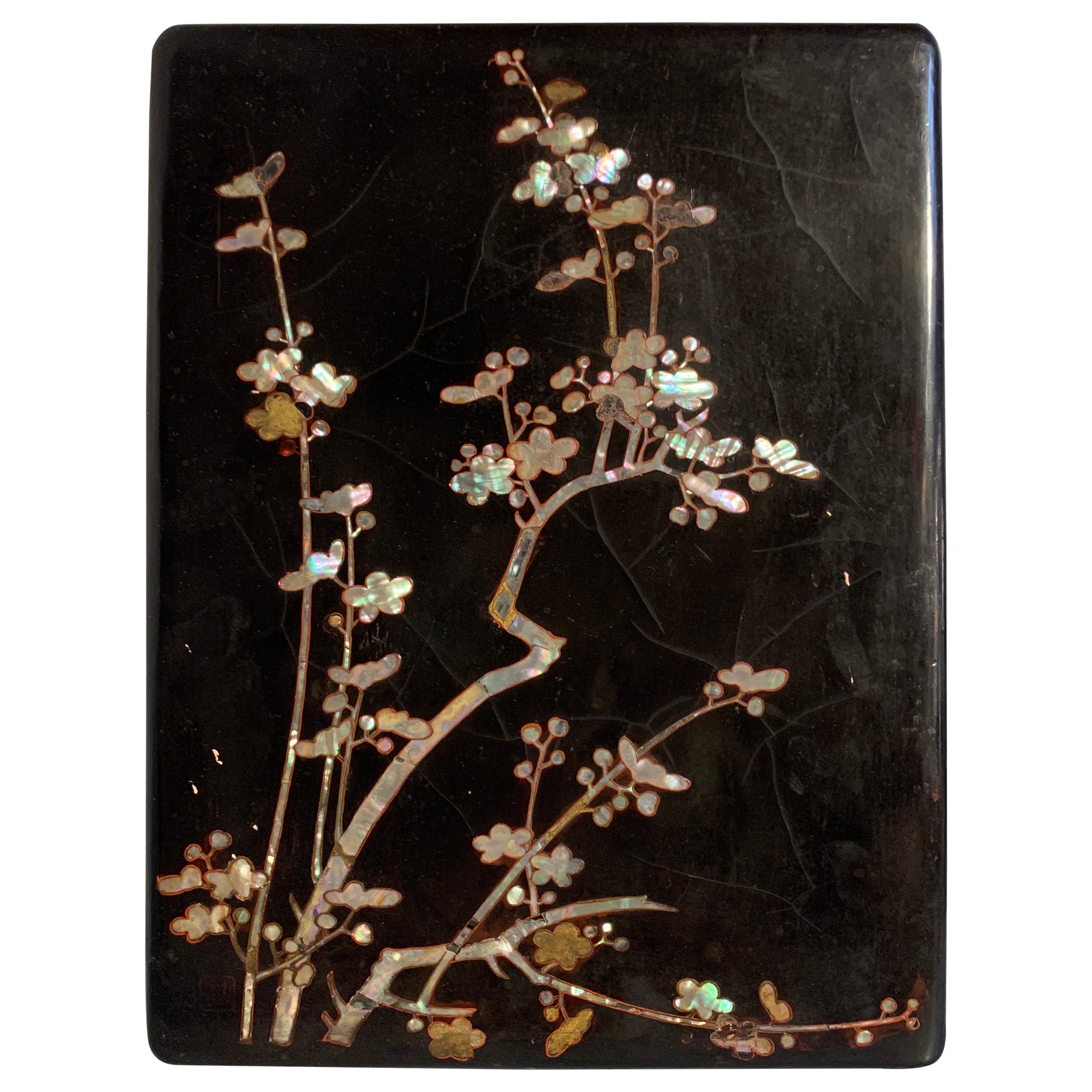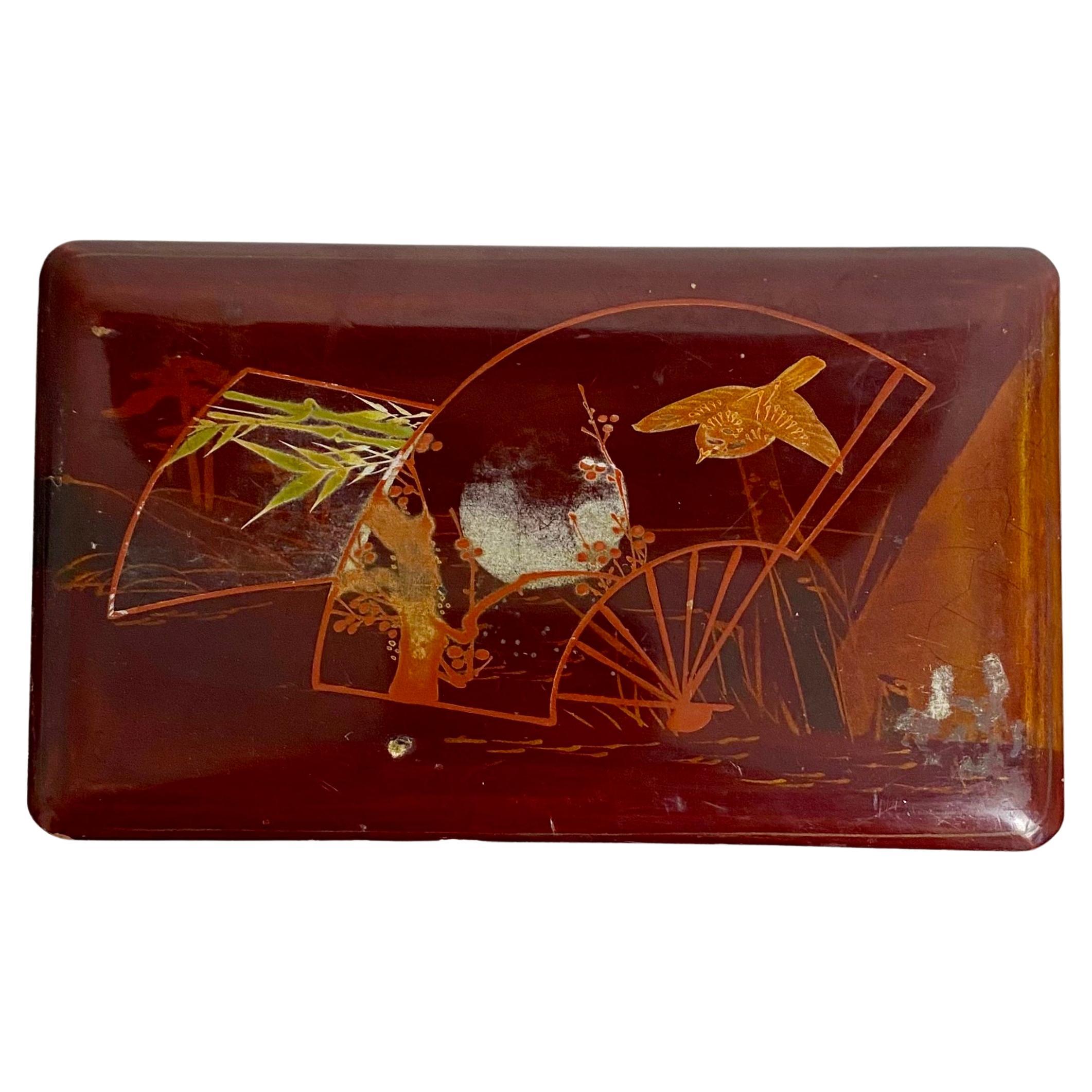Items Similar to Large Japanese Namban Lacquer Coffer Arqueta, 16th Century
Want more images or videos?
Request additional images or videos from the seller
1 of 5
Large Japanese Namban Lacquer Coffer Arqueta, 16th Century
About the Item
A large Japanese Namban lacquer arqueta coffer for the Portuguese market
Kyoto, Momoyama-period, late 16th century
In Hinoki cypress lacquered in black (urishi), decorated in gold lacquer (hiramaki-é), inlaid with mother of pearl (raden) and gilt copper mounts, three panels separated by geometric bands on the lid and body, showing flying long-tailed birds, a lion, butterflies and a tortoise amongst dense foliage of trees, bamboos and flowering plants.
Measures: H. 42 x W. 87.3 x D. 30 cm
Note:
Already in the late 16th century, several are documented in European royal collections. Later in the 17th century, after the Portuguese had been expelled from Japan in 1630 and the Dutch VOC traders were the only Europeans allowed in Japan, the style of the Japanese export lacquer boxes and coffers changed, becoming more pictorial in design, executed in gold lacquer (hiramaki-e and takamaki-e) on a plain black lacquered ground without separate panels, little or no inlay of mother of pearl and no longer with the semi-cylindrical lid (see: Japanese Export Lacquer, Oliver Impey & Christiaan Jörg, 2005). This Namban lacquered wood coffer of long rectangular form and semi-cylindrical lid is an example of the early type of Japanese export lacquers made for the Portuguese.
These larger coffers were called Arqueta and unlike the smaller boxes had carrying handles on the sides and all corners protected by gilt metal fittings. The Portuguese were the first Europeans in Japan and brought new furniture shapes which gave rise to a new type of Japanese lacquer-ware inspired by European models. The travelling Portuguese Jesuits and later the Spanish Franciscans missionaries ordered many small liturgical objects, such as altarpiece, crucifix, oratory and needed boxes or arqueta to transport or store these things, their other belongings and their garments. But more importantly, these boxes and coffers were among the first examples of Japanese export art to reach the (royal) European markets.
- Dimensions:Height: 16.54 in (42 cm)Width: 34.45 in (87.5 cm)Depth: 11.82 in (30 cm)
- Materials and Techniques:
- Place of Origin:
- Period:
- Date of Manufacture:1570-1600
- Condition:Wear consistent with age and use. Some fading to the lacquer on top, but in overall very good condition.
- Seller Location:Amsterdam, NL
- Reference Number:1stDibs: LU5458220859842
About the Seller
5.0
Vetted Seller
These experienced sellers undergo a comprehensive evaluation by our team of in-house experts.
Established in 1985
1stDibs seller since 2020
19 sales on 1stDibs
Typical response time: 3 hours
- ShippingRetrieving quote...Ships From: Amsterdam, Netherlands
- Return PolicyA return for this item may be initiated within 7 days of delivery.
More From This SellerView All
- Superb Late 16th Century Signed Colonial Japanese Namban Export Lacquer CofferLocated in Amsterdam, NLSuperb late 16th century signed colonial Japanese Namban export lacquer coffer Momoyama period, late 16th/early 17th century, inscribed 'Arisato' on the bottom H. 30.5 x W. 43...Category
Antique 16th Century Japanese Lacquer
MaterialsCedar, Lacquer
- Fine Japanese Namban Lacquer Jewelry Casket, 17th CenturyLocated in Amsterdam, NLJapanese Namban lacquer transition-style coffer with two drawers Kyoto/Nagasaki, circa 1650 The cartouches with gilt and red decorations of leaves...Category
Antique 17th Century Japanese Edo Lacquer
MaterialsCypress
- Unique 17th Century Miniature Japanese Namban Lacquer Miniature Dollhouse ChestLocated in Amsterdam, NLA unique and exceptional Japanese miniature or dollhouse export lacquered chest Kyoto, circa 1620-1640 The chest of rectangular shape with a domed lid, decorated in Transition-style, in gold hiramaki-e on a black background within reserved lobed cartouches decorated with landscapes animated with birds and rabbits, on a shagreen or samegawa background. The borders are decorated with geometric friezes, the box with gilt-copper mounts, the interior decorated in red lacquer. Measures: H 9.2 x W 14.5 x D 7.2 cm This miniature is of exceptional quality and a perfect copy of the famous large size Transition-style coffers. It was most likely ordered by a Dutch lady for her dollhouse (poppenhuis), like the famous Petronella Oortman (1656-1716) doll-house, which is now one of the highlights in the collection of the Rijksmuseum Amsterdam, or Petronella Oortmans-de la Court’s (1624-1707) dollhouse in the collection of the Centraal Museum Utrecht. Sara Rothé of Amsterdam in 1743 ordered a miniature black lacquered ivory tripod table with gold chinoiserie decoration by Jurriaan Buttner (Monika Kopplin, European Lacquer, 2010, p. 56). Other Japanned dollhouse...Category
Antique 17th Century Japanese Edo Lacquer
MaterialsShagreen, Cypress
- A rare Japanese Namban export lacquer coffer with Mon emblemsLocated in Amsterdam, NLLate Momoyama period, late 16th century The coffer is decorated in black lacquer, urushi, on cedar wood, decorated with gold dust and silver, maki-e, and nashiji, mother-of-pearl, r...Category
Antique 16th Century Japanese Lacquer
MaterialsSilver, Copper
- 17th-Century Japanese Namban Lacquer Coffer on French Stand, Possibly by BoulleBy André-Charles BoulleLocated in Amsterdam, NLAn impressive and large Japanese 'Namban' transition-style lacquer coffer with fine gilt copper mounts on a French Re´gence base, possibly by André-Charles Boulle (1642-1732) Kyot...Category
Antique 17th Century Japanese Lacquer
MaterialsBrass, Ormolu
- Japanese Nagasaki Export Lacquer Box with Depiction of the 'Trippenhuis'Located in Amsterdam, NLA Japanese Nagasaki export lacquer box with mother-of-pearl depiction of the Amsterdam ‘Trippenhuis’ Edo-period, circa 1830 H. 12.5 x W. 24 x D. 15 cm ? The house depicted on t...Category
Antique 19th Century Japanese Edo Lacquer
MaterialsMother-of-Pearl, Lacquer
You May Also Like
- Japanese Lacquer Incense Box, Kogo, Momoyama or Edo Period, 16th/17th CenturyLocated in Austin, TXA wonderful Japanese lacquer incense box, kogo, with a design of sparrows in flight, late Momoyama or early Edo Period, circa 1600, Japan. The small box, called a kogo, was used t...Category
Antique Early 17th Century Japanese Edo Lacquer
MaterialsGold, Pewter
- Japanese Momoyama Period Black Lacquer and Mother of Pearl Box, 16th CenturyLocated in Austin, TXA fine and unusual Japanese black lacquer and mother of pearl inlaid box, Momoyama Period, 16th century, Japan. The large box and cover featu...Category
Antique 16th Century Japanese Edo Lacquer
MaterialsLacquer, Abalone
- Japan Red Lacquered Box 19th centuryLocated in Beuzevillette, FRBeautiful Japanese box in red lacquered wood; 19th century The lid is decorated with a landscape with a bird, trees and a setting sun. The inside of the box is covered with a lacque...Category
Late 20th Century Decorative Boxes
MaterialsWood
- Japanese Lacquer Hokai Box, 19th CenturyLocated in Pasadena, CAThis is a good example of a traditional Japanese Hokai shell storage box for the Kai-awase game. This box is well-detailed in chased brass appliques and makie. The box is in overall ...Category
Antique Late 19th Century Japanese Japonisme Lacquer
MaterialsWood, Lacquer
- Japan Red Lacquered Box 19th CenturyLocated in Beuzevillette, FRBeautiful Japanese box in red lacquered wood. The lid is decorated with flowering magnolia branches and signed by the artist. The inside of the box is covered with a paint loaded wit...Category
Antique Late 19th Century Jewelry Boxes
MaterialsWood
- Japan Red Lacquered Box 19th centuryLocated in Beuzevillette, FRBeautiful Japanese box in red lacquered wood. The lid is decorated with golden herons and flowering tree branches and signed by the artist. Black flowers are painted around the box. ...Category
Antique Late 19th Century Decorative Boxes
MaterialsWood
Recently Viewed
View AllMore Ways To Browse
New Used Furniture
Antique New Furniture
New Antique Furniture
Large Black Box
Japanese Wood Objects
Large Decorative Panel
Royal Japan
Butterfly Box
Butterfly Boxes
Royal Gold Box
Gilt Copper
16th Wood
Wood 16th Century
Antique Japanese Box Boxes
Antique Japanese Box
Antique Japanese Boxes Boxes
Antique Japanese Boxes
Japanese Box Antique
